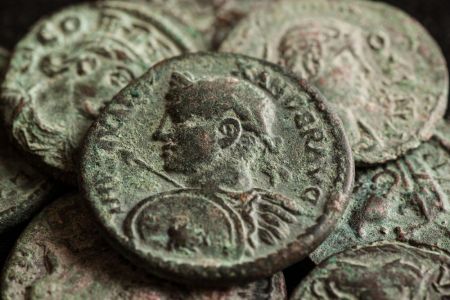Welcome to the Toolkit for Finds Reporting: Roman Coinage.
A pdf of this guidance is available in the Downloads section.
This short Introductory Video Guide provides an overview of the Toolkit and its resources, particularly the Roman Coin Recording Template.
The Toolkit for Finds Reporting: Roman Coinage is the nationally recognised guide for anyone engaged in the planning, commissioning, production or monitoring of a specialist report on Roman coins. It has been designed to be used for the reporting of Roman coin finds from all types of archaeological projects (surface collection, watching briefs, evaluations and full-scale excavations), and at all stages of a project’s life cycle (from initiation and planning, collection, post-excavation assessment and analysis, to the preparation of archive reports and publications).
This Toolkit has been created specifically to apply to archaeologically recovered coin assemblages (site-finds).
Following the FAIR Guiding Principles (Findability, Accessibility, Interoperability, and Reuse of digital assets), this Toolkit establishes the archaeological standard for the reporting of Roman coins.

The Toolkit is a guide to the reliable and consistent reporting of archaeologically recovered Roman coins. It is not the intention to dictate how the analytical process should take place as this depends on a combination of variables affecting the feasible level of analysis (eg, type of archaeological project, size and condition of the coin assemblage, nature of the excavated remains, project’s aims and objectives, etc). The standardised identification and quantification of Roman coins are, however, the necessary first steps towards the integrated, informative and meaningful analysis of these important artefacts as archaeological finds.
Identification and reporting of Roman coins should be undertaken by a specialist, or specialists, with experience of archaeology and numismatics.
An archaeological ‘specialist’ is defined by CIfA as:
An individual who is competent in, and specialises in, collecting, recording, analysing, interpreting and reporting on specific materials, objects or scientific data. A specialist will have developed expertise through the extensive study of their particular field, working to accepted standards of practice and ethics, and reporting in reputable peer-reviewed sources. They should also be accredited in line with any recognition schemes in place for their field of expertise. Membership of a study group or special interest group is a valuable way of acquiring and sharing knowledge and is also recommended.
This professional definition should be applied in conjunction with Rule 1.5 from from the CIfA Code of conduct:
A member shall not undertake archaeological work for which they are not adequately qualified.
Specialists who are able to bring together knowledge and expertise from archaeology as well as numismatics should be distinguished from their ‘pure’ numismatic and archaeological colleagues. Instead of ‘coin specialist’ or ‘applied numismatist’, a less ambiguous title for such specialists is archaeological numismatist.
Projects should ensure that they use the services of experienced finds specialists. Trainee or novice coin specialists should always work under the guidance of an established archaeological numismatist.
The Toolkit should be used in conjunction with the following CIfA Toolkits and Standards and guidance documents:
- CIfA standard and guidance for the collection, documentation, conservation and research of archaeological materials
- Toolkit for Recording Archaeological Materials
- Toolkit for Specialist Reporting
- Toolkit for Managing Digital Data (Dig Digital online resource)
- Toolkit for Selecting Archaeological Archives
- Management of Research Projects in the Historic Environment: The MoRPHE Project Managers’ Guide (PDF)
- MoRPHE (Management of Research Projects in the Historic Environment) Project Planning Note 3: Archaeological Excavation, Historic England (2008)

